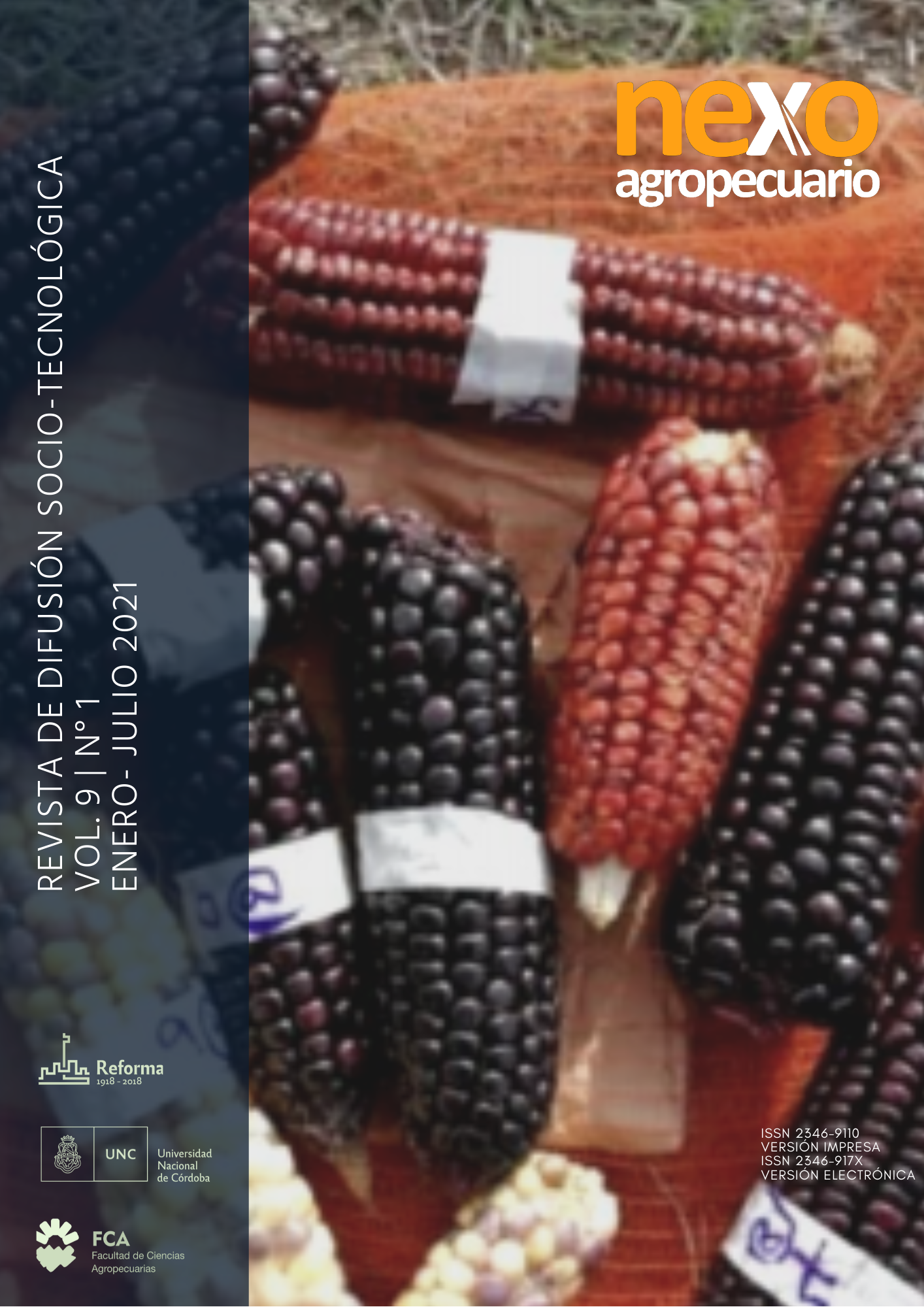EL CULTIVO DEL LINO (LINUM USITATISSIMUM L) EN EL CENTRO-NORTE DE LA PROVINCIA DE CÓRDOBA
Palavras-chave:
Linum usitatissimum, fecha de siembra, secano, rendimiento, region semiaridaResumo
El objetivo del presente trabajo consistió en evaluar el comportamiento agronómico del cultivo de lino conducido en secano en el centro-norte de la provincia de Córdoba a lo largo de un quinquenio en dos fechas de siembra. Se cultivó la variedad de lino Panambí a razón de 250-300 semillas viables m-2. Para el rendimiento en grano y sus dos principales componentes físicos o numéricos, el peso y el número de granos por unidad de superficie, se constataron interacciones significativas entre años y fechas de siembra. Para el rendimiento en grano, y en las campañas agrícolas 2014/15, 2019/20 y 2020/21, no se constaron diferencias estadísticamente significativas entre fechas de siembra. Es poco probable que en la región objeto de estudio el rendimiento por unidad de superficie supere las dos toneladas, de lo que se desprende que para que el lino se convierta en una actividad competitiva el precio del producto es determinante
Referências
Abd El-Mohsen, A. A., Abdallah, A. M., & Mahmoud, G. O. 2013. Optimizing and describing the influence of planting dates and seeding rates on flax cultivars under Middle Egypt region conditions. World Essays J, 1(4), 142-152.
Berglund, D. R., & Zollinger, R. K. 2002. Flax production in North Dakota.
Boletin de Divulgación N° 9. 8 de abril de 1971. http:// www.ainfo.inia.uy/digital/bitstream/item/5896/1/CIAAB-BD-8-1971.pdf.
Brigante, F. I., Mas, A. L., Pigni, N. B., Wunderlin, D. A., & Baroni, M. V. 2020. Targeted metabolomics to assess the authenticity of bakery products containing chia, sesame and flax seeds. Food chemistry, 312, 126059.
Flower, G., Fritz, H., Balneaves, L. G., Verma, S., Skidmore, B., Fernandes, R., Kennedy, D., Cooley, K., Wong, R., Sagar, S., Fergusson, D. & Seely, D. 2014. Flax and breast cancer: a systematic review. Integrative cancer therapies, 13(3), 181-192.
Gallardo, M. A., Milisich, H. J., Drago, S. R., & González, R. J. 2014. Effect of cultivars and planting date on yield, oil content, and fatty acid profile of flax varieties (Linum usitatissimum L.). International Journal of Agronomy, ID 150570, 7 pages, https://doi.org/10.1155/2014/150570.
Goyal, A., Sharma, V., Upadhyay, N., Gill, S., & Sihag, M. 2014. Flax and flaxseed oil: an ancient (medicine & modern functional food. Journal of food science and technology, 51(9), 1633-1653.
Jhala, A. J., & Hall, L. M. 2010. Flax (Linum usitatissimum L.): current uses and future applications. Aust. J. Basic Appl. Sci, 4(9), 4304-4312).
Katare, C., Saxena, S., Agrawal, S., Prasad, G. B. K. S., & Bisen, P. S. 2012. Flax seed: a potential medicinal food. J Nutr Food Sci, 2(1), 120-7.
Krishna Kumar, R., Bejkar, M., Du, S., & Serventi, L. 2019. Flax and wattle seed powders enhance volume and softness of gluten-free bread. Food Science and Technology International, 25(1), 66-75.
Kristensen, M., Jensen, M. G., Aarestrup, J., Petersen, K. E., Søndergaard, L., Mikkelsen, M. S., & Astrup, A. 2012. Flaxseed dietary fibers lower cholesterol and increase fecal fat excretion, but magnitude of effect depends on food type. Nutrition & metabolism, 9(1), 1-8.
Mirshekari, M., Amiri, R., Nezhad, H. I., Noori, S. S., & Zandvakili, O. R. 2012. Effects of planting date and water deficit on quantitative and qualitative traits of flax seed. American Eurasian Journal of Agricultural and Environment Science,12(7), 901-913.
Morris, H.M. 2007. Flax: A health and nutrition primer. Flax Council of Canada, Winnipeg, Canada, pp: 140.
Rajiv, J., Indrani, D., Prabhasankar, P., & Rao, G. V. 2012. Rheology, fatty acid profile and storage characteristics of cookies as influenced by flax seed (Linum usitatissimum). Journal of Food Science and Technology, 49(5), 587-593.
Ramírez, D. y Santamaría, V. 2013. Con el lino, la rotación vuelve a pintarse de celeste.http://agrovoz.lavoz.com.ar/la-voz-del-campo/con-el-lino-la-rotacion-vuelve-pintarse-de-celeste.
Silagadze, M. A., Kipiani, A. V., Pkhakadze, M. D., Berulava, I. O., & Pkhakadze, N. M. 2013. The linsed flax processing products in the production of baked goods. Annals of Agrarian Science, 11 (2), 75-78.
Villar, J., & Cencig, G. Evaluación de cultivares de lino en la EEA Rafaela. Campaña 2008. Publicación miscelánea. EEA Rafaela, (109).
Vitol, I. S., Pankratov, G. N., & Meleshkina, E. P. 2021. Biochemical characteristics of new varieties of flour from a binary mixture of wheat and flax. In IOP Conference Series: Earth and Environmental Science Vol. 640, No. 2, p. 022050. IOP Publishing.
Wirkijowska, A., Zarzycki, P., Sobota, A., Nawrocka, A., Blicharz-Kania, A., & Andrejko, D. 2020. The possibility of using by-products from the flaxseed industry for functional bread production. LWT,118, 108860.
Downloads
Publicado
Edição
Seção
Licença
Copyright (c) 2021 Ricardo Maich

Este trabalho está licenciado sob uma licença Creative Commons Attribution-NonCommercial-ShareAlike 4.0 International License.
Atribución – No Comercial – Compartir Igual (by-nc-sa): No se permite un uso comercial de la obra original ni de las posibles obras derivadas, la distribución de las cuales se debe hacer con una licencia igual a la que regula la obra original.


